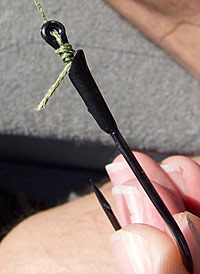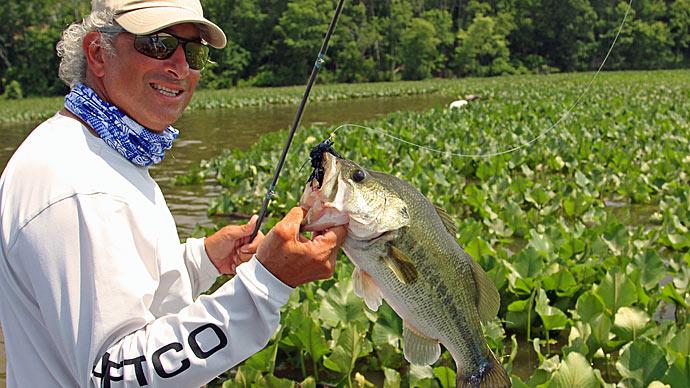
When the weather changes from summer to fall, it’s often still hot during the day, even though nights and mornings are cooler. Daniel Elias, a successful tournament angler based in Phoenix, targets bluegill-eating bass at this time of year to catch the big ones. Elias says that bluegills move around, get into vegetation during the day, and move around during cooler nights. It isn’t just the bluegills that seek shelter in the grass – crawdads like the shady coolness as well, and where the food is located, the bass will be there.
The grass bite usually gets better as the sun goes higher, so early in the day, he might start throwing a Texas-rigged Berkley Chigger Craw around the launch ramps and drop-offs, going to the thick grass later when the sun comes out and the fish hunker down in the shade. He rigs the Chigger Craw on a ¼-ounce tungsten weight and doesn’t peg. When we fished Saguaro Lake with him in mid-October, he started on the ramp in the marina and caught the first fish of the day off the rocks near the ramp before the sun was fully up.
The Texas rig is a great start bait while waiting for full sunlight, but Daniel has some rules. First, don’t peg the weight unless you’re fishing in grass or wood. Let the weight travel away from the hook for the best hooksets. Second, use the lightest weight you can get away with. As long as you can feel it, you’re okay. He likes the tungsten weights because they are compact and have a good feel on the line. Also, tungsten is harder, so it doesn’t get mashed at the top as lead can. When lead is banged repeatedly against the rock, the opening hole can deform and get a sharp edge – sharp enough to damage or even cut your line.
Once the sun gets a bit higher, it’s time to shift into punching mode. Daniel’s punching rod is a 7-foot 11-inch extra heavy Abu Garcia Villain with a high speed 8:1 Revo STX Abu Garcia reel, spooled up with 65-pound Spiderwire DuraBraid. The right rod, reel, and line are the keys to successfully punching the grass – you have to be able to feel the bites, and you need to be able to set the hook hard with a big hook and haul the fish and a whole bunch of grass up quickly. Sometimes you end up with so much grass around the fish you can’t even see the fish, and all that wet grass is heavy.
It's All In The Details

Elias uses a Strike King Rage Bug bait in green pumpkin purple or green pumpkin red because the bulky silhouette mimics the bluegills in Saguaro, as do those colors. The sunfish in your lake may be a different shade – choose a Rage Bug accordingly. The way Elias rigs the Rage Bug also contributes to his success. He starts by threading a bobber stopper onto the line. If the weight gets away, weeds can get between the bait and the weight, resulting in hang-ups. They come on a plastic ring with threading loops and are easy to use.
After the bobber stop comes the ounce and a half Bass Pro Shops XPS tungsten weight, he uses the painted ones for the most part, and when the paint gets worn off, he scalds the weights to turn them black. Then comes the green pumpkin punch skirt – a skirt resembling a spinnerbait skirt but tied on a bead to slide between the hook and the weight on a punch rig to shield the bait as it goes through the grass. Finally, he uses a 4/0 Berkley Fusion 19 Heavy Cover Hook and ties them on with a snell knot.
First, he threads the line through the hook eye from the point side. This is important. He then makes the loop and six wraps between the bait keeper on the shank and the eye. Once he passes the tag end through the loop and tightens it up, he’s got a solid knot that also helps set the hook – because the line passes through the point side first, when you apply pressure, it forces the hook into a position that is 90 degrees to the line. So when you yank, the hook swings right into the top of the bass’s mouth. All that’s left to do is rig the Rage Bug onto the hook – weedless, of course.

Saguaro Lake has large grass beds, and the grass can grow as deep as 25 to 30 feet when the water is very clear. Grass that deep doesn’t reach the surface, but you can fish it the same way. We were fishing grass beds that reached the surface or very near it, and Elias fishes them the way you would fish structure. There are points, walls, humps, and channels in the grass, plus those types of structure on the bottom under the grass. When it reaches the surface, the grass lays down and forms very dense mats, but underneath it is a lot more open. When you drop a nice bulky bait down there, the bass think it’s a bluegill, and they hammer it. This is not a stealth bite – Elias says it feels like a baby gorilla grabbed your line and yanked on it.
The bite isn’t subtle, but it IS brief – because the weight is so heavy, it doesn’t feel natural so that the bass won’t hang on long. You’re going to miss a lot of bites. That’s the reason for the extra heavy rod, braid, and fast reel. Also, Elias has taught himself to pitch left-handed, even though he’s right-handed. That way, if a fish bites on the drop, he’s always in a position to set the hook. His left hand never leaves that reel when he’s punching. The Fusion 19 hook also helps – he says it has a coating that makes it penetrate much more easily than regular hooks.
The bite can change even during the day. The fish might take it off the bottom, on the fall, or as you pick it up. He drops it down, picks it up, and moves on. If they start hitting it on the bottom, he’ll leave it there a bit longer; if on the drop, he keeps moving. Because the fish use different depths at different times, you must find them every time you go out. He starts by looking at the water level. If the water rises, that may push them into the tules near the shore. If the water is dropping, they’ll be further out. When you are faced with an entire cove full of grass, you need to think about things like that and focus on different kinds of structure within the weeks until you pinpoint their location. You look for points and dips and humps in the grass. If you can find a patch of grass next to a rock pile, your odds go way up.
He throws right in there when the fish are up shallow in the tules. If you look, you’ll see grass inside the tules as well. If he spots an opening behind a stand of tules, he’ll cast his Rage Bug right over them and into the opening. Elias likes to start fishing outside the grass and work his way in. He says a patch of grass the size of a boat can hold ten fish, and if you throw right into the middle first thing, you’ll spook them all.
Fishing the grass on a busy lake like Saguaro can be difficult because all the wake action and waves want to toss you around. The Minn Kota Talons on the back of the boat keep him securely locked in place, and he recommends them for any grass or bed fishermen. Finally, a Ninja Grass Blade is a huge help – it keeps the grass and weeds from choking your trolling motor blade. Just attach one to the motor, and it cuts the grass so you can keep fishing. Paying attention to details is what makes Daniel Elias such a successful angler. It can do the same for you.
BassResource may receive a portion of revenues if you make a purchase using a link above.




